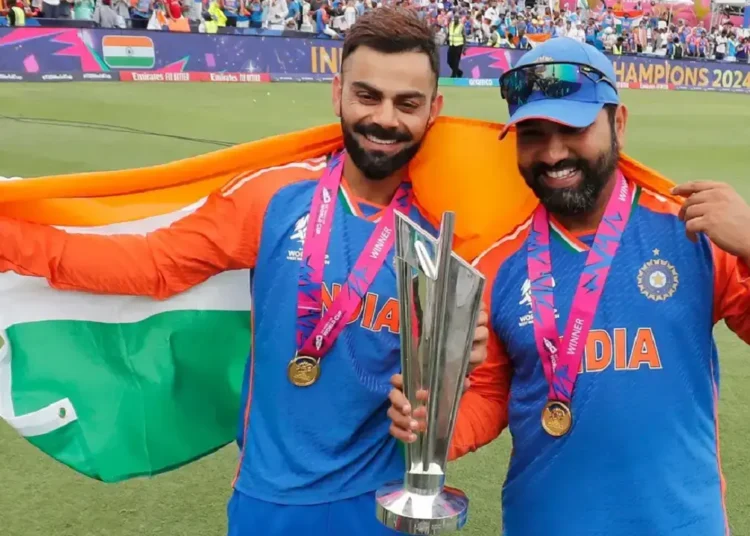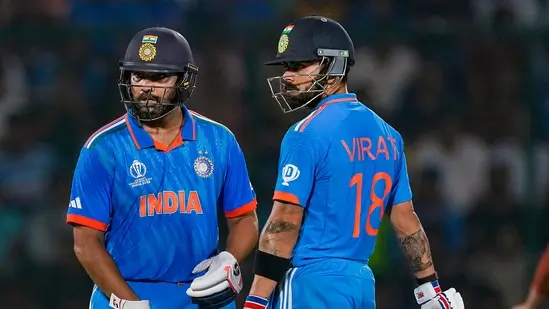Ajit Agarkar’s comments at the NDTV World Summit created big waves. He said clearly that Rohit Sharma and Virat Kohli are not on trial. His message reminded fans that experience cannot be judged by one bad series. These two have delivered results for India for over a decade.
The debate began as India prepared for the ODI series against Australia. Rohit and Kohli, now ODI-only players, remain central to India’s batting plans. Agarkar defended them, saying players of such stature need rhythm and time. He also hinted that long-term decisions for 2027 will take shape gradually.
Meanwhile, Mohammed Shami found himself in headlines over fitness concerns. Despite playing Ranji games, he wasn’t picked due to physical doubts. Agarkar explained that selectors depend on verified medical feedback, not just player words. His tone stayed calm and balanced, emphasising fairness and consistency.
This article explores whether Agarkar’s approach is practical or protective. It examines how selectors can respect legends while building for the future. It also looks closely at what Rohit, Kohli, and Shami mean for Indian cricket. Their next phase could decide India’s ODI path for years to come, to maintain the timeline.
Rohit and Kohli: Not on Trial, Still Crucial
Agarkar’s strongest message was about trust and perspective in selection. He said judging Rohit Sharma and Virat Kohli every series would be unfair. Both average close to fifty, proving long-term consistency despite changing roles. Their places, he said, depend on fitness and intent, not one-off failures.
The focus for selectors is balance, not bias. Veterans bring calmness when the team faces crunch chases or collapse. Their experience still holds massive value for younger teammates learning high-pressure cricket. Agarkar said the idea of trialling legends after decades of service is “silly.”
He pointed out that India’s next World Cup is two years away. Planning that early, he said, must consider unknown injuries and new faces. Rohit and Kohli’s main goal now is to stay ready and focused. Their performance should be tracked steadily, not judged by a single bad tour.
The reality is clear — legends can’t be replaced overnight. Their roles may evolve, but their wisdom keeps the dressing room grounded. Selectors who respect that stability will always manage smoother transitions. Agarkar’s stance, therefore, feels like a calculated, long-term move for team balance.
Experience vs Form: The Real Selector’s Dilemma
Form may fluctuate, but class never disappears completely. Selectors often get trapped between statistics and player aura. Agarkar reminded critics that players like Kohli and Rohit thrive under scrutiny. Their motivation grows when others start doubting their hunger and fitness.
The challenge lies in balancing emotional trust with performance data. Youngsters bring spark, but veterans bring mental stability during global tournaments. If both are used wisely, India’s transition becomes smoother. That’s why Agarkar’s patience deserves more credit than online noise.
Rohit Sharma: Redefined Leadership and Role in ODIs
Rohit’s journey continues to evolve with age and responsibility. Losing ODI captaincy didn’t reduce his authority or tactical influence within the group. He remains India’s best powerplay reader and calmest top-order anchor. Agarkar said his rhythm will improve once he gets continuous match practice.
Rohit’s ODI value lies beyond numbers — it’s about leadership energy. His mentorship helps Shubman Gill and young openers adapt under pressure. Managing workload is key since overexposure risks injuries and fatigue. Selectors will rotate him strategically to preserve his big-match form.
His consistency in major tournaments still defines India’s batting template. Rohit’s calm reactions help teammates navigate tense chases. That maturity will be vital when India builds toward the 2027 campaign. Agarkar’s confidence in Rohit’s process shows trust built on years of reliability.
India’s generational path can be understood better through history. You can view the India vs Bangladesh timeline to see how such transitions began earlier — it gives context to how senior players created paths for new stars.
Virat Kohli: Still Hungry, Still Irreplaceable
Kohli’s role now mirrors a master guiding an evolving orchestra. He may play fewer matches, but each appearance carries weight. Agarkar knows Virat Kohli’s preparation remains unmatched in modern cricket. His batting standards still define what effort means for younger teammates.
He walked away from Tests to open space for a new WTC cycle. Yet, his ODI commitment continues with clear intent and purpose. Kohli’s intensity drives the environment and keeps India mentally sharp. His batting, even at 36, remains textbook-perfect under pressure.
Selectors know dropping him isn’t just a tactical decision — it’s cultural. His example builds India’s discipline and work ethic every day. Agarkar’s stance ensures India doesn’t lose that engine of inspiration. It’s not favoritism, it’s about valuing experience that sustains team identity.
The next two years will decide his ODI journey’s pace. If fitness and focus remain high, his 2027 presence is possible. Until then, selectors will treat him as an asset, not an experiment. Kohli remains the heartbeat that makes India’s lineup feel secure.
Kohli’s Impact on India’s Transition Phase
Kohli acts as a bridge between past and emerging generations. His advice helps new players handle spotlight and workload better. His match awareness in tight chases still wins India crucial games. His leadership instincts continue even without the captain’s title beside his name.
Agarkar values him for consistency, fitness, and mental discipline. These qualities shape India’s professionalism beyond scoreboards. Keeping him around ensures stability during change. That’s why selectors still trust Kohli as India’s cultural pillar.
Mohammed Shami: The Fitness and Fairness Question
The selection debate turned sharper when Mohammed Shami voiced frustration online. He said if he could play Ranji, he could play ODIs. Agarkar replied respectfully, stating that selectors rely on verified medical updates. He emphasised fairness and said his phone stays open for all players.
Fitness remains the biggest selection filter in modern cricket. Even senior players must clear standard fitness tests before international return. Agarkar said Shami’s form wasn’t in doubt, only his readiness level. Selectors need more than one first-class game to certify long-term fitness.
If Shami bowls consistently through the Ranji rounds, doors reopen. Agarkar made it clear that no one is permanently out. This balance keeps competition alive but ensures safety for players and team. His calm reply turned a potential controversy into a professional discussion.
The message is simple — performance matters, but fitness sustains it. Data-based assessment now drives all selection calls. That ensures merit-based fairness across age groups. Shami’s return, when fit, will strengthen India’s pace attack significantly.
Why Fitness Transparency Strengthens the System?
Fitness protocols keep communication clean between selectors and players. It prevents confusion that once created public drama in Indian cricket. Players now understand their benchmarks clearly before major tournaments. This builds accountability without hurting personal pride or experience.
Agarkar’s transparency represents a more modern selection culture. The goal is to protect player longevity and maintain public trust. Shami’s case is a reminder that even veterans need monitoring. It’s professional, not personal, and ensures readiness before big assignments.
The Selectors’ Balance: Youth, Experience, and the Future
Agarkar’s challenge is maintaining fairness while planning for renewal. Young players deserve chances, but seniors add structure and calmness. The balance between energy and experience keeps a team healthy and confident. Agarkar’s tone reflects patience, not panic, during a sensitive transition.
He knows decisions made now will shape India’s 2027 campaign. A short-term mindset risks breaking continuity, something he wants to avoid. Each player, from Kohli to Gill, has a clear purpose within plans. The mix of mentorship and youth forms India’s strongest foundation.
Communication plays a huge role in his selection process. He interacts with players, understands recovery cycles, and listens before reacting. That’s what defines a good selector — judgment backed by empathy and data. Agarkar’s approach may seem cautious, but it’s built for stability.
Fans often seek quick changes, but consistency builds winners over time. Agarkar’s method reminds India that evolution beats revolution in cricket. The next two years will prove if this strategy delivers trophies again. Until then, the focus stays on trust, patience, and performance.
Conclusion
Ajit Agarkar’s approach is less emotional and more structured. He understands that Rohit Sharma and Virat Kohli are beyond trial-level debates. His role is to manage time, not chase social-media opinions. His steady tone reflects the maturity needed during generational change.
Rohit and Kohli still add unmatched value with bat and mind. Their mentorship builds India’s next ODI leaders silently from within. Agarkar’s clarity gives the team room to evolve without drama. Shami’s fitness issue shows selectors treat everyone under the same rules.
This is how strong systems sustain for years without collapse. India’s selectors now balance performance, fitness, and development equally. The 2027 World Cup cycle demands experience and fresh energy in equal measure. Agarkar seems focused on that exact formula.
Right or wrong, his calm leadership feels timely and practical. It helps Indian cricket shift smoothly into its next ODI era. If results match this reasoning, Agarkar’s method will be validated soon. For now, he’s building India’s future — one steady selection at a time.











